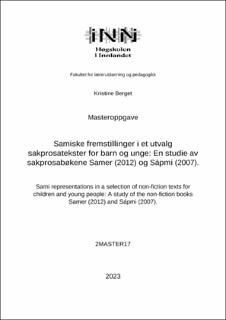| dc.contributor.advisor | | |
| dc.contributor.author | Berget, Kristine | |
| dc.date.accessioned | 2023-07-01T16:10:21Z | |
| dc.date.available | 2023-07-01T16:10:21Z | |
| dc.date.issued | 2023 | |
| dc.identifier | no.inn:inspera:136491409:37620729 | |
| dc.identifier.uri | https://hdl.handle.net/11250/3075109 | |
| dc.description.abstract | Denne masteroppgaven posisjonerer seg innenfor forskningsfeltet for barnelitteratur, og omhandler en studie av sakprosabøkene Samer (2012), skrevet av Sigbjørn Skåden, og Sápmi (2007), skrevet av Elisabeth Johansen og John Roald Pettersen. Problemstillingen for dette prosjektet er: Hvordan fremstilles samer i to sakprosabøker for barn, og i hvor stor grad kan sakprosabøkene bidra til å utvide barneleserens urfolksperspektiv?
Med fagfornyelsens benevnelse av urfolksperspektivet, skapes det rom for å stille kritiske spørsmål til om det finnes mer enn ett perspektiv på samer, og slik bidra til å utvide barneleserens urfolksperspektiv. Fremstillinger av samer i sakprosalitteratur kan gi svar på dette. Tidligere forskning innad i det barnelitterære sakprosafeltet påpeker en økende interesse for visuell kunnskapsformidling som likestilles med den verbale. Det er derfor interessant å undersøke hvordan samer fremstilles i sakprosalitteratur for barn og unge gjennom både verbalspråklige og visuelle elementer.
Min metodiske inngang til prosjektet er en postkolonialistisk nærlesning av mine to sakprosabøker og et analyseverktøy utviklet for å kunne analysere sakprosa for barn og unge (Goga, 2019, s 15). I mine analyser har jeg lagt vekt på verbale og visuelle fremstillinger av samer, og siden kunnskapsformidlingen om samer foregår gjennom flere modaliteter, er det hensiktsmessig å anvende begreper fra både multimodalitetsteori og bildebokteori. Postkoloniale perspektiver og begreper innenfor den postkolonialistiske diskursen er viktige å benytte for å belyse de samiske fremstillingene. Gjennom analysene finner jeg at begge sakprosabøkene domineres av tradisjonelle fremstillinger av samer, og det er særlig de gjentakende visuelle beskrivelsene av koftekledde samer som forsterker dette inntrykket. Disse kan ses som gjennomgående symbolske attributter, som er med å gi samer felles identitet, noe som gir lite rom for nyanserte fremstillinger av samer. For leseren kan denne mangelen på nyanserte fremstillinger føre til stereotypi, og skape en avstand til det fremstilte som blir både annerledes, fremmed og eksotisk. Samtidig er det aspekter ved de to bøkene som kan bidra til å utvide barneleserens urfolksperspektiv. Begge bøkene inneholder mange direkte spørsmål som forfatterne stiller barneleseren om samene, og disse kan bidra til å skape refleksjon, engasjement og kritisk tenkning når forholdene ligger til rette for det. Aller best i klasserommet gjennom utforskende samtaler, der lærer oppmuntrer elevene til å undre seg og finne svar på spørsmålene, samtidig som de innehar en kritisk holdning til kunnskapen om samer som presenteres for dem. Elevene kan slik utvikle bedre innsikt og forståelse for hvem samene er, og diskutere om det finnes flere enn ett perspektiv på samer. | |
| dc.description.abstract | This master's thesis positions itself within the research field of children's literature, and deals with a study of the non-fiction books Samer (2012), written by Sigbjørn Skåden, and Sápmi (2007), written by Elisabeth Johansen and John Roald Pettersen. The research question for this project is: How are Sami people portrayed in two non-fiction books for children, and to what extent can non-fiction books contribute to broadening the indigenous perspective of the child reader?
With the renewal's designation of the indigenous perspective, space is created to ask critical questions as to whether there is more than one perspective on the Sami, and thus contribute to expanding the child reader's indigenous perspective. Depictions of Sami in non-fiction literature may provide answers to this. Previous research in the field of children's literature points to a growing interest in visual knowledge dissemination that is equated with verbal. It is therefore interesting to study how Sami people are portrayed in non-fiction literature for children and young people through both verbal and visual elements.
My methodological approach to the project is a postcolonial close reading of my two non-fiction books and an analysis tool developed to analyse non-fiction for children and young people (Goga, 2019, p. 15). In my analyses I have emphasized verbal and visual representations of Sami, and since knowledge dissemination about Sami takes place through several modalities, it is appropriate to apply concepts from both multimodality theory and picture book theory. Postcolonial perspectives and concepts within the postcolonial discourse are important to use to shed light on the Sami representations. Through the analyses, I find that both non-fiction books are dominated by traditional representations of Sami, and it is especially the repetitive visual descriptions of the Sami kofta that reinforces this impression. These can be seen as consistently symbolic attributes, which gives the Sami a common identity, which leaves little room for nuanced representations of the Sami. For the reader, this lack of nuanced representations can lead to stereotyping, creating a distance from the portrayed that becomes both different, alien and exotic. At the same time, there are aspects of the two books that can help broaden the child reader's indigenous perspective. Both books contain many direct questions that the authors ask the child reader about the Sami, and these can help create reflection, engagement and critical thinking when the conditions are right. Best in the classroom through exploratory conversations, where the teacher encourages the students to wonder and find answers to the questions, while at the same time possessing a critical attitude towards the knowledge about the Sami that is presented to them. In this way pupils can develop a better insight and understanding of who the Sami are, and discuss whether there is more than one perspective on the Sami. | |
| dc.language | nob | |
| dc.publisher | Inland Norway University | |
| dc.title | Samiske fremstillinger i et utvalg sakprosatekster for barn og unge: En studie av sakprosabøkene Samer (2012) og Sápmi (2007). | |
| dc.type | Master thesis | |
